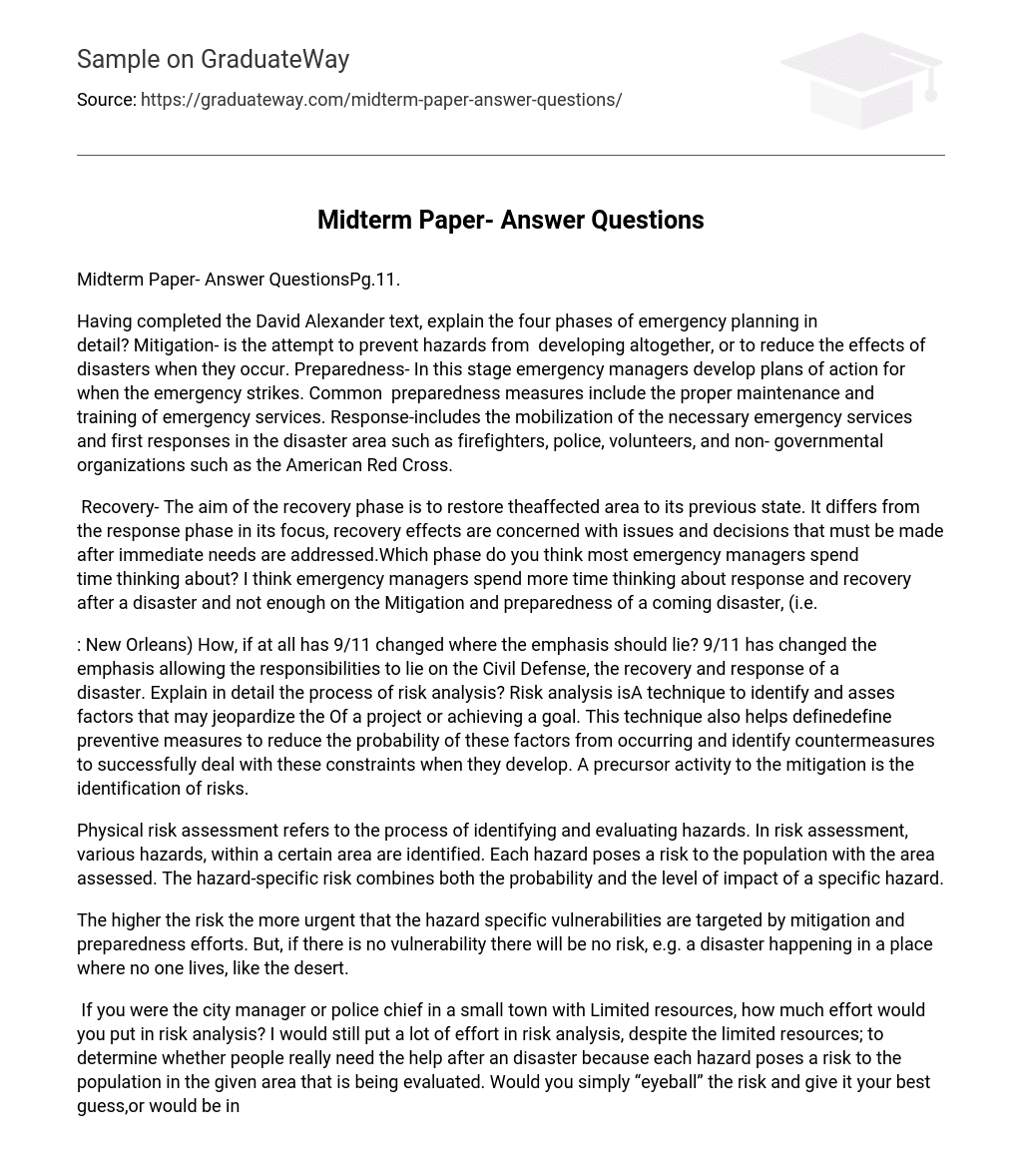Having completed the David Alexander text, explain the four phases of emergency planning in detail?
- Mitigation- is the attempt to prevent hazards from developing altogether, or to reduce the effects of disasters when they occur.
- Preparedness- In this stage emergency managers develop plans of action for when the emergency strikes. Common preparedness measures include the proper maintenance and training of emergency services. Response-includes the mobilization of the necessary emergency services and first responses in the disaster area such as firefighters, police, volunteers, and non- governmental organizations such as the American Red Cross.
- Recovery- The aim of the recovery phase is to restore theaffected area to its previous state. It differs from the response phase in its focus, recovery effects are concerned with issues and decisions that must be made after immediate needs are addressed.
Which phase do you think most emergency managers spend time thinking about?
I think emergency managers spend more time thinking about response and recovery after a disaster and not enough on the Mitigation and preparedness of a coming disaster, (i.e. : New Orleans)
How, if at all has 9/11 changed where the emphasis should lie?
9/11 has changed the emphasis allowing the responsibilities to lie on the Civil Defense, the recovery and response of a disaster. Explain in detail the process of risk analysis? Risk analysis isA technique to identify and asses factors that may jeopardize the Of a project or achieving a goal. This technique also helps definedefine preventive measures to reduce the probability of these factors from occurring and identify countermeasures to successfully deal with these constraints when they develop. A precursor activity to the mitigation is the identification of risks.
Physical risk assessment refers to the process of identifying and evaluating hazards. In risk assessment, various hazards, within a certain area are identified. Each hazard poses a risk to the population with the area assessed. The hazard-specific risk combines both the probability and the level of impact of a specific hazard. The higher the risk the more urgent that the hazard specific vulnerabilities are targeted by mitigation and preparedness efforts. But, if there is no vulnerability there will be no risk, e.g. a disaster happening in a place where no one lives, like the desert.
If you were the city manager or police chief in a small town with Limited resources, how much effort would you put in risk analysis? I would still put a lot of effort in risk analysis, despite the limited resources; to determine whether people really need the help after an disaster because each hazard poses a risk to the population in the given area that is being evaluated.
In other words, what can emergency managers and disaster planners do to facilitate such care?
Second communications will be used at the request of the emergency manager, the facilities maintenance and control center. The control center will relocate to an emergency center and will staff the center continuously during the emergency. Easels with information should be set up in the lobby of universities to inform people of the latest drill from the Emergency command center. An advisory hotline number should be establish to enable people to call for information on where to go during a disaster. A medical center website homepage should be also be established as well as a voice mail system to broadcast information relating to said emergency. The emergency manager will coordinate releases of information to the media.
An individual will be designated to interface with one-site media representatives. Public radio stations will be contacted as necessary to spread information relating to openings or closing of shelters or universities during the emergency. The emergency manager or disaster planner will maintain a log of events and time of the emergency. This log is to indicate the time of the incident, give a brief description of the incident and the individual involved along with their affiliation.
The third is mobilization if so directed by the emergency director will be used as the mobilization point to deploy the work force needed for the duration of the emergency. An assessment is made by the emergency manager to decipher the need for additional personnel resources.
If necessary assistance may be obtained from the local hospital. What makes a good emergency or disaster planner?
What makes a good emergency or disaster planner is to have effective and orderly government control and to coordinate all emergency operations within the scope of the state’s status. To develop and maintain the states county’s comprehensive emergency management plan and provide emergency planning for the entire county. To coordinate emergency management activities, services, and programs within the county including:
- Teaching people how to get through a disaster.
- Helping to equip local first responders
- Making disaster assistance available to community, businesses, and people. Training and emergency simulations.
- Create reviews and provides technical assistance for all Health Care Facilities such as Hospitals, Nursing homes, Adult living Facilities and ambulatory Surgical centers.
Emergency management serve as a liaison to the state division of Emergency Management and the other local emergency management agencies and organizations. They also serve as a liaison and the coordinator of municipalities’ requests for the State and Federal assistance during pre and post-disaster operation.What personnel attributes would contribute to the success of such an official? Attributes would include a personable, ethical, person who knows what would be right for the safety of an population during a disaster.





